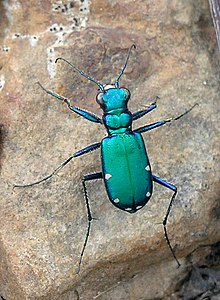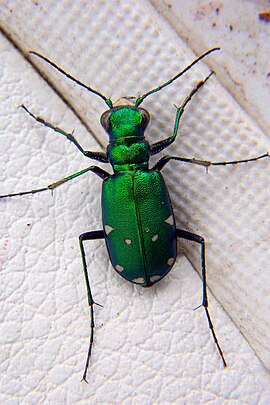Cicindela sexguttata
| Cicindela sexguttata | |
|---|---|

| |
| Scientific classification | |
| Kingdom: | |
| Phylum: | |
| Class: | |
| Order: | |
| Family: | |
| Genus: | |
| Species: | C. sexguttata
|
| Binomial name | |
| Cicindela sexguttata Fabricius, 1775
| |
The six-spotted tiger beetle, also known as the six-spotted green tiger beetle (Cicindela sexguttata), is a common North American species of ground beetle in the Cicindelinae subfamily.
Description
They are commonly found in deciduous forests in between Minnesota,[1] Rhode Island, and Ontario and south to Kentucky, and are easily recognizable by their large, white, overlapping mandibles. The adult is 12–14 mm (1/2-5/8") in length,[2] and has fairly long legs. The mandibles give these attractive insects a ferocious appearance. While tiger beetles are voracious predators of small arthropods, they do not bite humans unless handled, and their bite is such a mild pinch that it is barely noticeable. Both the common name and the species name refer to the number of small white spots on the back of the beetle's metallic-green to metallic-blue-green abdomen, usually numbering six. This is not always the case, however, as some individuals may have more spots,[3] fewer spots, or none at all, presumably due to genetic mutations. Tiger Beetles like to live in woody places, and they are especially fond of shady openings such as dirt paths and fallen logs to hunt caterpillars, ants, spiders, and many other kinds of arthropods. Although tiger beetles are not gregarious, many beetles may sometimes be seen on one log. The female lays her eggs in sandy patches, and the larvae burrow into the ground after they hatch. Here they lie in wait until small arthropods pass by, at which time the larvae pounce out of the soil like jack-in-the-boxes. The beetles develop as larvae for about one year before pupating, and the insect has a total lifespan of just under 5 years.
Gallery
-
Cicindela sexguttata
-
Cicindela sexguttata
-
Cicindela sexguttata, Belleplain State Forest, New Jersey, USA.
References
- ^ Val Cervenka (November–December 2013). "Beetlemania!". DNR. Minnesota Conservation Volunteer: 61.
- ^ Milne, Lorus (2000). National Audubon Society Field Guide to North American Insects & Spiders. Alfred A. Knopf. ISBN 0-394-50763-0.
{{cite book}}:|work=ignored (help) - ^ "UW-Milwaukee: Field Station - Bug of the Week: Tiger Beetles". UW-Milwaukee: Field Station. Retrieved 1 July 2014.
External links
 Media related to Cicindela sexguttata at Wikimedia Commons
Media related to Cicindela sexguttata at Wikimedia Commons Data related to Cicindela sexguttata at Wikispecies
Data related to Cicindela sexguttata at Wikispecies- Cicindela sexguttata, BugGuide
- Cicindela sexguttata, Tiger Beetle of Connecticut
- Cicindela sexguttata, Tiger Beetles of Ontario
- Tiger Beetles, Canadian Biodiversity Web Site



